Ukraine refugee response monitoring in UNICEF Romania - meeting the challenges in information management
The ActivityInfo team would like to thank Ms Tetyana Nikitina, Planning Monitoring and Evaluation Manager, Mr. Marius Chiricuta, Information Management Officer, Ms. Sanja Dimitrijevic, Reporting Officer and Mara Matei, Programme Officer in UNICEF Romania as well as the Ms. Diana Pirga, Social and Behaviour Change Consultant and the online United Nation Volunteers for their valuable insights in this Case Study. We extend our thanks for the support of UNICEF Romania Country Office Management team and ECARO Regional Office Emergency, Planning and Programming teams.
UNICEF is a UN agency that works in over 190 countries and territories to protect and support the full realization of rights of every child including in emergencies. In Romania, UNICEF has been advancing the children's rights agenda for thirty years via country programs conceptualized and implemented in collaboration with the government.
When the Humanitarian Crisis in Ukraine began in February 2022, the country office in Romania and other UNICEF offices in the region needed to quickly adapt to the new situation by expanding their operations to cover the complex and diverse needs of Ukraine refugees. The country offices with pre-2022 crisis programmes for social-sector system strengthening had to –concurrently with the emergency response– continue their pre-existing development programmes to reach all children in need, especially as COVID-19 pandemics had previously exacerbated socio-economic vulnerabilities and led many children into precariousness.
In 2023, UNICEF in Romania collaborated with a larger network of stakeholders and ran a wide variety of both development and humanitarian activities. Ukraine's refugee crisis response has been an unprecedented experience for not only Romania but the entire region. The large-scale emergency response created the potential for the region to work on addressing previously insufficiently unexplored –yet persisting challenges, through a nexus of different approaches emerging from described experience and to explore new ways of working and extending partnerships for children.
In the early days of this new context, it quickly became apparent that there was the need for a flexible and efficient information management approach that would provide insights and data to, on one hand feed regular and accurate reporting on the humanitarian situation in the country and, on the other hand, form the backbone of complex planning and coordination of the emergency response. ActivityInfo proved effective in addressing the ever-relevant challenge of real-time data collection, management and usage in emergencies. The experience of UNICEF in Romania in this regard offers interesting insights and perhaps innovative approaches to the issue, including expanding the usage of ActivityInfo to streamline different functions in the office as shared below. As the new context settled in, the Regional Refugee Response Plan coordinated by UNHCR and the UNICEF Humanitarian Appeal for Children called for more reliable and regular data supply tracking and showcasing progress, reach and impact of the planned interventions.
The country office had to monitor the activities and capture results in diverse situations, locations, program areas and by multiple partner organizations. At the same time, because the situation was always evolving there was the need for a system that would be flexible enough to adapt and reflect these changes without burdening the partners working in the field. A few weeks into the response, UNICEF in Romania started using ActivityInfo to address these challenges.
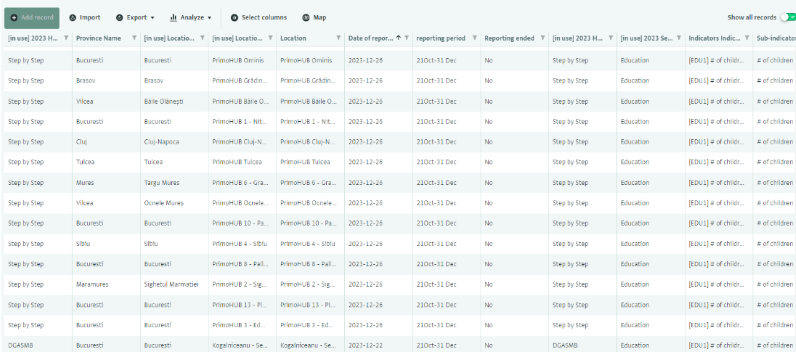
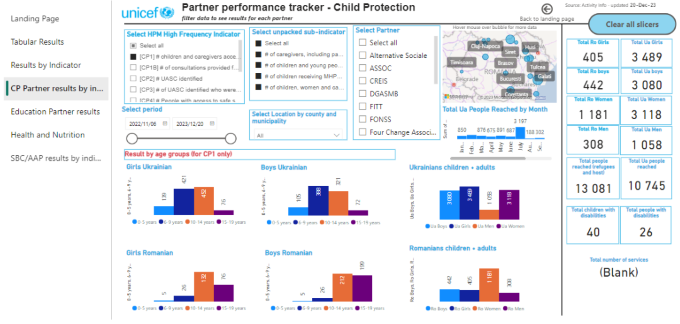
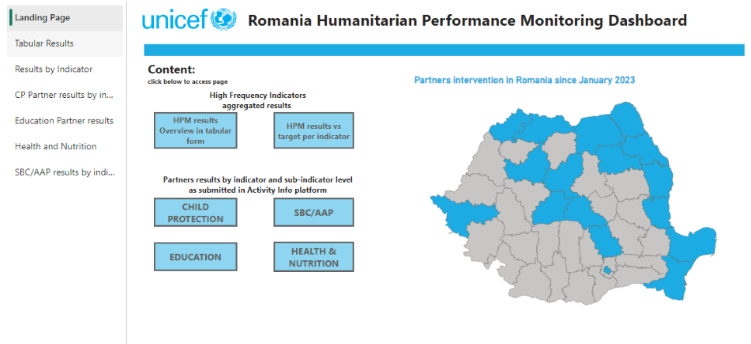
Soon, the Information Management (IM) team realized that they could expand the use of the platform to simplify more information management tasks and enhance collaboration between diverse stakeholders in different settings. It was also presented to the Interagency information management group and to the UNICEF Regional Office IM team.
“For information management, ActivityInfo and similar tools are ideal. However, as a Planning, Monitoring and Evaluation Manager, I have a broader set of responsibilities and tasks, so I was trying to see how ActivityInfo can be adapted to these”, explained Tetyana.
In this Case Study, we explore how UNICEF in Romania reinvented the use of the ActivityInfo platform for response monitoring and created tools to support information management in a variety of contexts including narrative reporting, social media monitoring, fundraising, and supply distribution. The article covers the scope of 2022-2023 response interventions.
Addressing urgent requirements: supply distribution monitoring in ActivityInfo
In the early months of the response, the internal supply distribution system was still under development for the country. However, the country office needed to monitor the distribution of supplies to beneficiaries as they were happening so as to provide accurate figures for situation reports and other reporting requirements.
The IM team designed a supply distribution monitoring system in ActivityInfo so as to collect the requests and deliveries from their colleagues while they were waiting for the official system to launch.
“There is a well-developed UNICEF global monitoring system that is part of our accounting and financial system, with oversight from our Supply Division. But because the country was not involved in such massive supply delivery before, we had never rolled it out before. At that time, when we needed the figures at our fingertips to report, we needed something that would allow us not only to say how many items we have ordered but also how many of them we have actually distributed to the beneficiaries. So to fill in the gap while we were rolling out the supply distribution monitoring in Romania, we used ActivityInfo as a handy and easy-to-use interim solution. Activityinfo came to rescue for an immediate need at that time”, explained Marius.
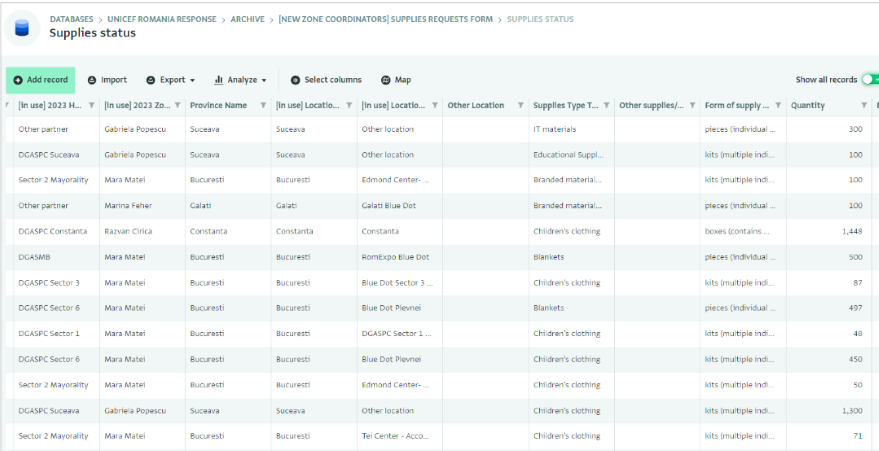
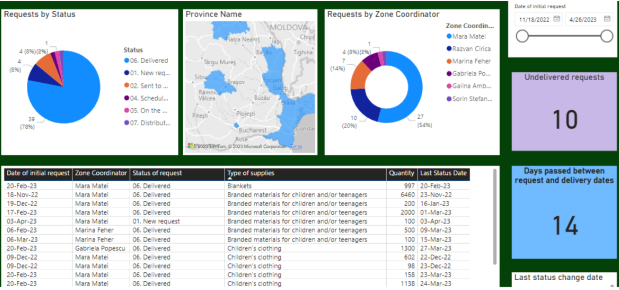
From partner response monitoring to key narrative snapshots
In April 2022, the UNICEF country office created a simple form in ActivityInfo to collect information from partner organizations so as to monitor the first results coming from UNICEF's partners’ activities in the field. In 2023, as the new regional and interagency plans came into action and more partners joined the interventions, the approach to reporting became more systematized.
All partners received an orientation session and a package of training materials, including detailed guidance. In 2024, having learnt from the previous years, the IM team has redefined the approach and simplified reporting for 28 partner organizations using the platform. The changes were easy to implement from one year to the next in ActivityInfo because older forms could be re-adapted to reflect new circumstances and there was no need to build a whole system from scratch.
Having solved the challenge of partner response monitoring, the IM team explored more ways to support stakeholder collaboration and communication and decided to move a reporting process based on Word documents exchange to ActivityInfo.
“At that time we had seven programme officers based in different regions of Romania with the highest refugee population, which interacted with our partners, with the government and the coordination groups at the county level. They had direct access to stakeholders and beneficiaries at the ground level and they had first-hand information.
We wanted to support our emergency coordinator, to provide them with a snapshot of what was happening in the field at any given time without overloading the people who were working there. We also wanted to document all the learning and findings coming directly from the field and make use of them close to real time. We started with a Word document that they had to send to the emergency coordinator at regular intervals”, explained Tetyana.
The Word document was adapted and turned into a simple form in ActivityInfo that allowed capturing information for multiple locations - split into several categories for the ease of analysis (e.g. important changes in the programming context; key meetings with government stakeholders, coordination fora; meetings with civil society).
The main difficulty was related to the fact that it was not about figures, but qualitative information. Hence, the form offered a short introduction and guidance on how to be filled - to collect short but relevant narratives from the zone coordinators. The IM team also provided explanations on what needed to be reported and feedback following the analysis of the reports.
“For me, the platform is user friendly and easy to use. Sometimes I wonder if I choose the right outputs for each field visit. But from a technical point of view, I use it easily” stated Mara Matei, Programme Officer.
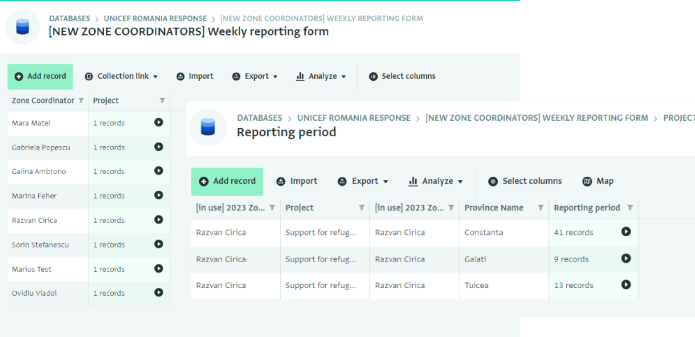
The form was then connected via the ActivityInfo API to PowerBI and the reported information was turned into a dynamic dashboard, accessible to stakeholders.

“The dashboard is published on Romania's internal team site and it's accessible to everyone. It's like a very informative bulletin. What's beautiful about ActivityInfo is the API integration to PowerBI. We can simply filter information based on data such as the date of submission, the location or even by the name of the colleague who has added the information into the platform”, added Marius.
Systematizing the reasoning behind monitoring: a new approach for more structured narratives from partners and volunteers
In addition to partner organizations, UNICEF in Romania is collaborating with the online United Nations Volunteers (UNVs), a team of volunteers supporting social media monitoring and listening for the response. Part of their work is to provide reports on their findings on media monitoring.
Similarly, other partner organizations also provide their own narrative reports in regards to the response. Initially, the analysis and compilation of the online UNV data took place in Excel spreadsheets and would require time to filter and group the information.
Taking inspiration from the form created for the narrative snapshots, the IM team in the country office offered an alternative solution by integrating both the online UNVs and partners’ narrative reports under one form in ActivityInfo. Then, with a Power BI dashboard the collected information was made accessible to all involved colleagues.
"Utilizing the ActivityInfo platform has significantly improved the process of structuring my weekly reports for the UNICEF Romania online volunteering project. This platform provides a centralized and organized space where I can efficiently create reports divided by topics and easily share them with my project coordinator.
By leveraging ActivityInfo's features, I've been able to create customized reports tailored to the specific needs of UNICEF Romania's Ukraine crisis response. This ensures that the data collected aligns seamlessly with the project's objectives.
The ActivityInfo platform has been instrumental in optimizing the workflow of structuring and managing weekly reports for the online UNV project, ultimately contributing to a more efficient and impactful collaboration", stated one of the online United Nations Volunteers.

“The SBC team has been using ActivityInfo to gather inputs from the volunteers monitoring Ukrainian Telegram groups as part of the Social Listening program. Even since the beginning we have noticed that the volunteers were reporting more than via email, sign that having the ActivityInfo form set-up on subjects made it easier for them to report, then, for data analysis it is very helpful to have all information in one place and even have it historically kept in a database for easier reference, data manipulation and even to be able to easier detect trends, spikes.
Another important improvement ActivityInfo brought to our work was related to time optimization, while gathering inputs via email, arranging them to have the same flow so we can analyze, with this tool, the data manipulation time dropped significantly.” Ms. Diana Pirga, SBC Consultant for UNICEF.

"Having ActivityInfo as the source of information is very useful. All this information which is collected from ActivityInfo comes into this beautiful dashboard and colleagues can actually select what they want to see based on their interest, on sector or topic", said Marius.
This new approach introduced a different, structured process and systematized not only the work but also the way of thinking in the organization. The online UNV team approached the monitoring and reporting having specific questions in mind based on the form in ActivityInfo.
“This particular approach allowed us to revisit and refine our own way of thinking as an office and with the colleagues involved in the Accountability to Affected Population area in terms of what exactly we are doing, what channels we are using, what types or categories of feedback we are mainly looking into and how we can feed this information back into the program decisions that we need to make together with the emergency coordinator and the program colleagues.
With ActivityInfo, this has also become much easier because when the volunteers are going through social media, they already apply these lenses and they can easily fish out the necessary information from the sources they use for monitoring. For example, what are the main needs expressed, what are the main sentiments, what are the main ideological issues or are there economic issues the affected population is talking about? So this gives them a very good structure before going through multiple entries in the social media and other channels”, added Tetyana.
Expanding the use: Fundraising tracker in ActivityInfo
As the country office expanded, the development of proposals increased too. As a result and due to the nature of the proposals, there was an urgent need for better documentation and coordination between all stakeholders involved in proposal development.
While developing a dashboard in PowerBI for finance, the IM team in UNICEF Romania realized that they could combine its data with data about proposals sourced in ActivityInfo instead of Excel spreadsheets or Sharepoint.
Because of their ‘3D’ nature, spreadsheets were not an adequate solution for the diversity of the situations for which the office was submitting proposals. For example, there were a variety of programmatic areas to which they were submitting proposals or some proposals would be submitted to different donors. Also, with spreadsheets there could be more errors due to uncontrolled edits.
As a result, the IM team created a simple form in ActivityInfo to apply a structure to the information collected about each proposal such as name, amount, programmatic area, donors involved and more.
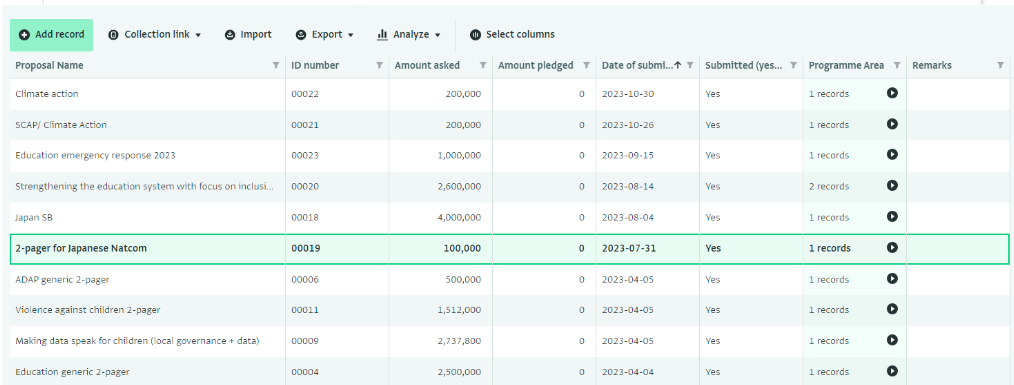
Then, by integrating the form with Power BI this data was combined with finance data coming from other internal systems and it became possible to not only have an overview of the proposals but also detect funding gaps and how the proposals were contributing to closing these gaps.

"With Excel, the main problem is that the spreadsheets are 2D, whereas a database is 3D. It allows you more extensive and sophisticated sorting and filtering and gives you the answers you need. We needed something better than an Excel table where once you input something with a small mistake, you can't use it", explained Tetyana.
Conclusion
The IM team in UNICEF Romania went a step beyond partner and activities monitoring and explored new approaches and ways that the ActivityInfo platform could be implemented to support both the work within the office but also the work of partners. From documenting narratives for key snapshots and media monitoring to a fundraising tracker and a supply distribution monitoring system, the IM team invented remarkable tools to support the response and streamline not only the information management processes but also their way of thinking about them.
“A realization we reached is that working with all these databases, trying to make them useful and as simple as possible helped us internally to streamline our own thinking in terms of the operationalization of the response plans and also of what we call ‘making the data speak’.
Because in order to produce a simple dashboard you have to do such massive thinking. You need to consider the needs of the end-user, leading you to the understanding of what kind of data needs to be collected, what the output should be, how to present this and how to show the results. It needs a lot of back and forth, brainstorming, even reverse thinking to conceptualize all this”, concluded Tetyana.
The ActivityInfo team would like to thank Ms Tetyana Nikitina, Planning Monitoring and Evaluation Manager, Mr. Marius Chiricuta, Information Management Officer and Mara Matei, Programme Officer in UNICEF Romania as well as the SBC and the online United Nation Volunteers for their valuable insights in this Case Study. We extend our thanks for the support of UNICEF Romania Country Office Management team and ECARO Regional Office Emergency, Planning and Programming teams.